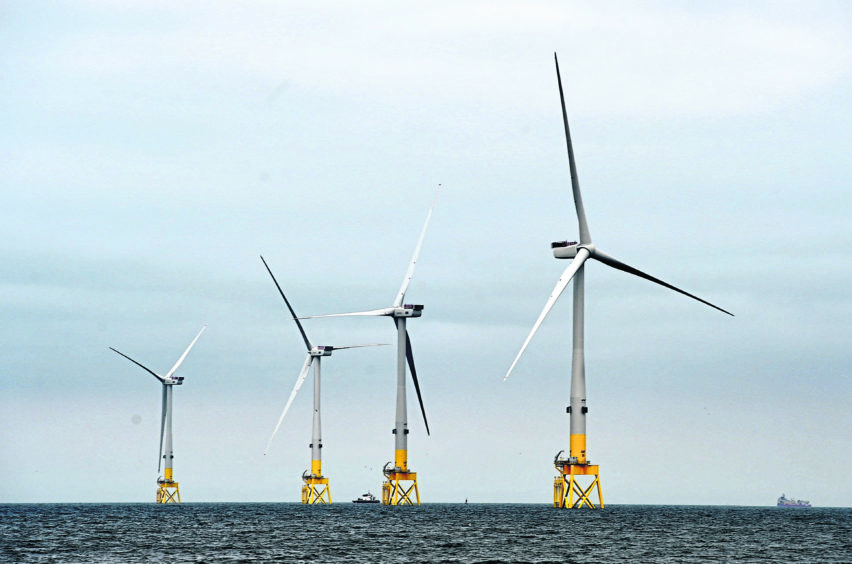
Vattenfall’s Aberdeen Offshore Wind Farm could generate more than £100 million for the north-east economy over the next two decades, according to a new study.
Research carried out by Oxford Brookes University shows spending linked to the operations and maintenance (O&M) of the wind farm may create between 40 and 50 full time equivalent (FTE) jobs each year.
Those are expected to be through locally based contracts with suppliers and onward spending within the local community.
However, it also revealed that the value of the offshore construction stage to both the local and Scotland-wide economies was overestimated.
Vattenfall’s 96.8 megawatt (MW) 11-turbine development, also known as the European Offshore Wind Deployment Centre (EOWDC), first became operational in July 2018 and has the capacity to power 80,000 homes.
The Socio-Economic Impacts Monitoring Study carried out by Oxford Brookes and supported by the Swedish energy company, is part of a wider £2.75m programme, dubbed the EOWDC Environmental Research and Monitoring Programme.
It will also examine bird and marine life around offshore installations and is thought to be the largest research programme of its kind in the world.
The socio-economic findings claim that, for the operation and maintenance stage, the Environmental Statement (ES) predictions were for 660 FTEs to be created over the life of the project and gross value added (GVA) of £20m.
But, according to the report, the overall contract value of the O&M stage may be at least £3m per annum, with a multiplier impact of up to another £3m, giving the project total expenditure of more than £100m over its 20 year life.
EOWDC’s operations and maintenance team is based in Aberdeen Harbour.
The study also claims that, due to staff being local and on long contracts, there is a higher multiplier impact, with between 40 and 50 jobs being supported every year, giving 800-1000 FTEs over the life of the project.
However, it also showed that, due to the small nature of the project, the short build period and the availability of workers with the required skills, during construction a large percentage of the offshore team came from outside the local area.
According to the data, the offshore construction workforce is believed to have consisted of around 10 Scots among a peak workforce of 500 people.
Vattenfall’s Unlock our Future Fund, which awarded £200,000 in its first two rounds, was also deemed to be a “very good example of a community benefits initiative”.
Alexandra Richards, operations and maintenance manager at Aberdeen Offshore Wind Farm, said: “Despite having just 11 turbines, albeit some of the most powerful in operation in the world today, Aberdeen Offshore Wind Farm is already proving its worth to the local area. We couldn’t be prouder of what our wind farm means for Aberdeenshire, and through the Unlock our Future Fund, the project will leave a legacy even after it has reached the end of its lifespan.
“There’s a tendency to assume that the opportunities linked to wind farms begin and end with construction. But as this study shows, the main advantages for the community and local economy come from the long-term operations and maintenance phases, which generate significant amounts of spending and jobs.
“With the Prime Minister having just announced ambitious plans for a huge increase in the UK’s offshore wind capacity, there’s a massive opportunity to build up the supply chain in this country. It’s very likely that much larger offshore wind farms, like Vattenfall’s planned Norfolk Vanguard and Boreas projects, will be worth billions of pounds to the economy over their lifespan, with multiple benefits for communities close by.”
Professor John Glasson, research lead for the Oxford Brookes University team, added: “The impacts of offshore wind farms on the human environment, and especially on local and regional communities adjacent to such projects, is an under-researched area. Such communities are often suffering greatly from the decline in traditional industries, such as shipbuilding, fishing and tourism.
“Human environmental impacts include a wide range of social and economic issues. However, a lack of knowledge on the actual impacts of such projects can greatly hamper case management.
“There is a need for adequate planning and assessment tools for the key stakeholders – developers, consultancies, local, regional and national governments, development agencies and the general public— who are the audience for this Guidance Report. The aim is to aid the enhancement of local benefits and facilitate a positive developer-community relationship over a project’s lifecycle.”
Jean Morrison, chair of Aberdeen Renewable Energy Group (AREG), said: “This research shows that, as a pioneering project, the Aberdeen Offshore Wind Farm has created significant economic and employment opportunities for the north east of Scotland.
“The experience and knowledge built through the development of the EOWDC has also identified where there are skills gaps regionally and is allowing us to create a stronger local supply chain. Through our membership, we are seeing many businesses diversifying operations and I would expect these specialist skills to be utilised for future offshore wind projects.”
Recommended for you

